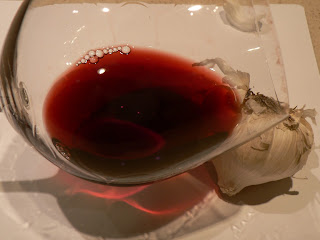 Purchased 2009-10-04 at Hannaford supermarket in Yarmouth, for $13.00Sight:
Purchased 2009-10-04 at Hannaford supermarket in Yarmouth, for $13.00Sight: Bright medium garnet moving quickly toward brick. Pretty, with no great depth of color. Looks older than it is, with telltale onionskin highlights at the edges.
Nose: Gentle forest floor – damp leaves and freshly sliced mushrooms. Allspice, black cherry jam, ripe raspberry, leather, prunes, dried cranberry, bit of quiet vanilla, amaretto, seasoned split firewood. Part of the fruit element is a bit wizened, but not with any of the over-ripe raisined quality of an Amarone, say. The intensity is moderate, but everything that
is there is very appealing and balanced. At first the nose was plummy and round and puddingy like a good minor Pomerol, but after a couple hours of air it is now more Burgundian, with the fruit notes sharper and more attenuated, and the autumnal qualities more in the foreground. This kind of development in the glass is immensely appealing – what makes wine interesting.
Palate: Sweet plum fruit. Tannins obvious but very soft and savory. Beef au jus. (What it is and probably what it likes … but we had it with chicken in brown gravy and mashed potatoes, which was a fine match too.) Very good merlot typicity. Later, the flavors become less black and more red, with some brandy and cinnamon elements emerging, like a spiced sour cherry tart. Again, moving away from Pomerol toward Beaune. Two excellent experiences for the price of one! Blurb on label mentions olives but I’m not getting that. Okay, now I am. (Power of suggestion?) But in an entirely good way, like a hint of rich, mild, meaty Gaeta olives, not the vegetably green-olive thing that characterized so many central coast reds twenty five years ago.
Finish. Medium length, but growing longer as the bottle sits open. Earlier, the soft tannins were the satisfying show, but now the acid / fruit balance is more prominent. Very good. Brandied quality there that stops just short of being too alcoholic. Wood is present but totally integrated and understated. This is really a nice bottle.
One of the great joys of wine (and life) is its unpredictability. How is this bottle improbable? Let me count the ways: 1) I bought it in a big chain supermarket. 2) It’s a merlot.* 3) It’s from California.** 4) It was very reasonably priced. 5) It is a perfectly mature red wine. 5) It has a level of development and complexity and sophistication that I would be happy to get in a $30 bottle of wine these days. Very nice surprise at this price level.
Is this a great wine? No. Is it a big, attention-grabbing wine? No. Will it get any better? No. Does it pass the drinkability test?*** Yes. Is it a great and affordable introduction to what five years in the bottle can do for a modest wine that is nonetheless balanced enough to handle it? Yes. How often to you get to try a decent wine with some enhancing age on it, right off the shelf? Seldom. Go try it and learn what maturity is all about. Then, in your life, follow the example this wine sets. Age gracefully. Don't overreach, but let all you have hang out unapologetically.

* Unlike some folks who have taken a few too many cues from Sideways, I am not at all prejudiced against merlot. I love good merlot. I’d be a fool if I didn’t. (Ever hear of a little thing called Petrus?) Its just that in my sub-twenty-dollar price range there are SO many tedious over-priced examples out there that after a while you give up from sheer enervation.
** For decades, California, among all the famous wine-producing regions of the world, has consistently shown a truly stunning inability to provide interesting and yet non-freak-show wines for under about $40 in today’s money. Anyone wants to invite me over for some Kistler chardonnay, I’m there. (What can I bring?) Otherwise, you can come find me in the aisle where bottles from any of the dozens of regions in France, Spain, Germany, and Italy that are still churning out lovely bottles for less than $20 reside. And no, I did not omit Australia by accident. Chile? We’ll see. There are possibilities there.
*** Wait. What? Empty? Really? We just opened that bottle as you were putting the plates in the oven! How many glasses did you have? Two big ones? That’s all? Crap.













